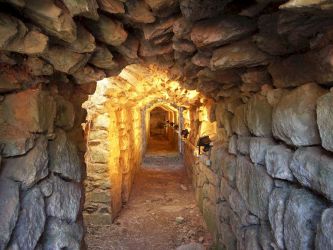Vetulonia
Vetulonia was one of the most important cities in Etruscan cities in the Maremma. It is located in the valley of the Bruna and extended its influence towards the Metaliferous Hills as far as Lake Accesa. Dionysius of Halicarnassus (first century BC) places the city within the Latin alliance against Rome in the seventh century BC. Pliny the Elder and Ptolemy also mention Vetulonia, and according to Silius Italicus (first century AD), the Romans took their magisterial insignia, the Lictors' rods and fasces and the curule seat, from Vetulonia. In 1898, a tomb in the necropolis was discovered with a bundle of iron rods with a double-headed axe in the centre, and soon afterwards, a grave stela inscribed for Avele Feluske was discovered, on which a representation of the fasces was engraved.
It seems that two settlements originally existed, that were then combined around the seventh century BC. The archaeological findings turned up inside the monumental tombs (jewels, metal objects, and imported manufactures) testify that the pinnacle of Vetulonia's splendour dates back to the historic phase known as the 'orientalising period' that witnessed the solidifying of a commercial network between Etruria, Greece and the middle east. The following century (sixth century BC) was marked by a clear decline of the fortunes of Vetulonia as it lost control over the Colline Metallifere. The clash between the Roman civilisation and the Etruscan civilisation, that had already begun around the middle of the fourth century BC, saw the progressive absorption of the Etruscans. The Vetulonia of the Roman age always remained a centre of little importance.
It seems that two settlements originally existed, that were then combined around the seventh century BC. The archaeological findings turned up inside the monumental tombs (jewels, metal objects, and imported manufactures) testify that the pinnacle of Vetulonia's splendour dates back to the historic phase known as the 'orientalising period' that witnessed the solidifying of a commercial network between Etruria, Greece and the middle east. The following century (sixth century BC) was marked by a clear decline of the fortunes of Vetulonia as it lost control over the Colline Metallifere. The clash between the Roman civilisation and the Etruscan civilisation, that had already begun around the middle of the fourth century BC, saw the progressive absorption of the Etruscans. The Vetulonia of the Roman age always remained a centre of little importance.
The Mura dell'Arce (cyclopean walls) probably date from the sixth and fifth centuries BC, and aerial photography has revealed further stretches, indicating the political and commercial importance of Vetulonia, which was famous for its goldsmiths. Under the Roman Empire, however, it shrank to become a secondary centre, with the northward spread of malaria. Little is known also about mediaeval Vetulonia. It was an object of contention between the abbots of San Bartolomeo di Sestinga and the Lambardi family of Buriano, and was then acquired by the Massa Marittima in 1323. Nine years later it passed under the control of Sienna.


